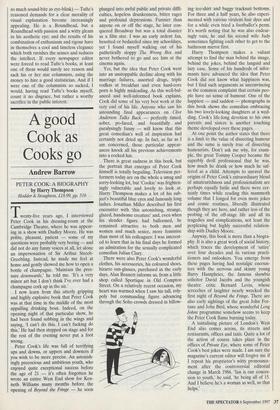Seeing is believing
Michael Bywater
VISUAL EXPLANATIONS by Edward it Tufte Graphics Press UK £28.00, pp. 157 We live surrounded by wily, unscrupulous persuaders, advertisers, mar- keting men, data-miners, politicians, pun- dits, health fascists, sharks after our money, puritans whose lives are governed by the terrible thought that someone, somewhere, may be happy. The wise journalist's prime mandate — to ask himself, at all times, `Why is this bugger lying to me?' — should be adopted by everyone who wishes to sur- vive the Information Age (which is really the Marketing Age, which in turn is no more than the Snake-Oil Age dressed in a plausible suit and carrying a notebook computer) with their faculties and fortunes intact.
On a plinth in our secret, unassailable minds should be a statue of Edward Tufte; and on our bookshelves should be his books, of which this is the third. The first was The Visual Display of Quantitative Information, and such joys and wonders have not been concealed behind so uninvit- ing a title since The Origin of Consciousness in the Breakdown of the Bicameral Mind, Julian Jaynes's magnificently wild-eyed jeu d'esprit. VDQI was about pictures of num- bers — 'How to depict data and enforce statistical honesty', as Professor Tufte puts it, and God knows we need to know at a time when every newspaper editor flings statistics at his readers without having the remotest notion what they really mean or how they came to be constructed. (You'll probably have seen the advertisement for VDQI, reproducing that wonderful graphic chart of Napoleon's march on and retreat from Moscow, in which, at a glance, the whole terrible picture was revealed.) Professor Tufte's second masterpiece was Envisioning Information, a book 'about pictures of nouns': maps, for example, and aerial photographs, described by the Amer- ican Mathematical Monthly, in their dry, mathematical, monthly way as 'brilliant, magnificent'.
And now we have Visual Explanations, a book about verbs, about things happening, about change over time, 'explanation and narrative. Since such displays,' says Tufte, `are often used to reach conclusions and make decisions, there is a special concern with the integrity of the content and the design.'
That the three books are visually enthralling is beyond debate. Tufte has taken charge of their design and publica- tion himself, and he and his artists, Bonnie Scranton, Dmitry Krasny and Weilin Wu, have produced near-perfect exemplars of the subjects he discusses. But there's far more to them than that. Enlightenment springs from every page, whether he is dis- cussing Humphry Repton's use of dodgy scale-figures to flog his pricy landscape rethinks, the fruity dissembling of the Mag- ellan space-probe video, the lessons to be learned from the instruction-sheets for conjuring tricks and their application to heart surgery and public speaking, the best way to present medical records, or the worst way to present the sort of engineer- ing reports such as those which directly led to the catastrophic explosion of the Chal- lenger space shuttle on January 28, 1986.
And with Tufte's meticulous and graceful exposition of truth and rigour come their converses: an understanding of the decep- tions practised on us daily, of the indisci- pline and sloppy thinking that have led to the execrable excesses (particularly in the United States) of political correctness, the persecution of tobacco-smokers, the jittery caterwauling of self-appointed guardians of public health, the narrow-gutted scaremon- gering of food-and-cancer activists, and all the other cheats and charlatans and special pleaders who exploit our susceptibility to visual obfuscation.
As we move more and more towards a culture whose infrastructure is primarily visual — driven not only by television, but, increasingly, by the world-wide Web (not `These three panels show some fish magic, the 'distraction display' of the colourful male stick- leback, as it seeks to lure a group of egg-eating predators away from its nest. Several methods depicting movement combine to create a lively narrative of threat and decoy: (1) separate dia- grams show paragraphs of activity, (2) dotted lines track motion within images, and (3) just as a sequence of varying positions of a single object indicates motion, here varying postures of the many fish together signal motion. The three panels are separated by a gentle and effective visual move, simply the absence of background; heavy-handed compartments made from thick lines are never necessary in order to tell one image from another. This is a superb arrangement, a design so good as to be unnoticeable, transparent to the interesting content at hand.' so much sound-bite as eye-blink) — Tufte's reasoned demands for a clear morality of visual explanation become increasingly appealing. He is a Roundhead, but a Roundhead with passion and a witty gleam in his aesthetic eye; and the results of his combination of enthusiasm and rigour have in themselves a cool and timeless elegance which both ravishes the senses and seduces the intellect. If every newspaper editor were forced to read Tufte's books, at least one of them would surely see reason and sack his or her star columnists, using the money to hire a good statistician. And if I were one of the columnists so sacked, I would, having read Tufte's books myself, count it no disgrace, but rather a worthy sacrifice in the public interest.



























































 Previous page
Previous page